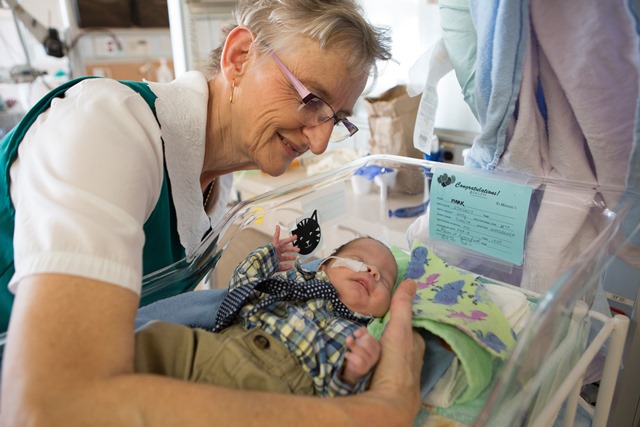
By James Wysotski
Parents of premature babies in St. Michael’s Neonatal Intensive Care Unit cannot be at their child’s side 24-7, but now a piece of them can.
With the recent launch of the NICU Cozy Cloth Program, parents can leave a triangular piece of fabric with their scent under their infant’s head in the isolette or bassinette.
“Parents worry about bonding with their baby when they leave at the end of the day, so it’s a huge source of comfort that their baby can still smell them,” says Amanda Hignell, the social worker from the NICU who developed the program.
Parents receive two cozy cloths and are encouraged to wear them under their clothes for 20 minutes so that their scent can permeate the fabric. While the cloths are sized and shaped to fit easily into bras, Hignell said both parents can take part. However, all research to date has focused on the mother-baby relationship.
“Introducing odours of the mother’s breast milk or amniotic fluid is soothing to babies and helps improve their neurodevelopment,” says Hignell. “Another benefit is reduced crying, as well as eliciting a suckling reflex, which is important because that skill is challenging to preemies younger than 35 weeks – and NICU babies tend to be much younger. Teaching babies to suck helps get them feeding sooner by mouth instead of nasal-gastric tubes,” she adds.
While no studies explain the benefits of fathers leaving their scents, Hignell said she hoped to facilitate paternal bonding as well. “A lot of dads do skin-to-skin kangaroo care while in the hospital, and we know the babies thrive with that, so I can’t imagine why cozy cloths with their scents wouldn’t work the same way,” notes Hignell.
 While cozy cloths are new for St. Michael’s, the idea isn’t. A few babies transferred from other hospitals’ NICUs arrived with cozy cloths. Sensing the added comfort for both parents and infants, staff here wanted to start a similar program.
While cozy cloths are new for St. Michael’s, the idea isn’t. A few babies transferred from other hospitals’ NICUs arrived with cozy cloths. Sensing the added comfort for both parents and infants, staff here wanted to start a similar program.
Hignell enlisted the help of volunteer Jannie Henkelman, a NICU baby-cuddler, to run the new program. Together, they got Fabricland to donate all of the materials. Henkelman co-ordinates the distribution of patterns and materials to volunteer sewers, as well as the pickup of finished products.
A crew of five assembles cloths by diagonally folding 10 by 10 inch squares of cotton flannel, pre-cut by Henkelman, and sewing all of the open edges except for a small hole through which the cloths will be turned inside out. But first, to keep infants safe, excess material at the corners is trimmed, thereby assuring flat, rounded corners after inversion. Then the opening is stitched shut. Each cloth takes about eight minutes to sew. For infection control, the cloths are laundered upon pickup before being placed into plastic bags that get added to the NICU’s Family Welcome Packages.
The crew has already made 250 cozy cloths. But with 30 admissions per month to the NICU, Henkelman said the need for more is great.
“Volunteering for this task is rewarding”, says Henkelman. “How satisfying it is to be able to do something as simple as this to enhance the bonding process between preemies and their parents.”
To help make cozy cloths, email Jannie Henkelman at cozycloth.smh@gmail.com.
James Wysotski works in communications at St. Michael’s Hospital.

